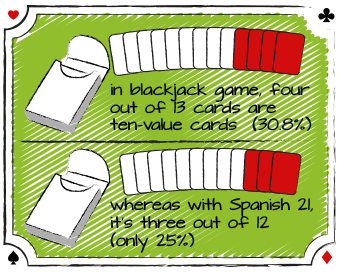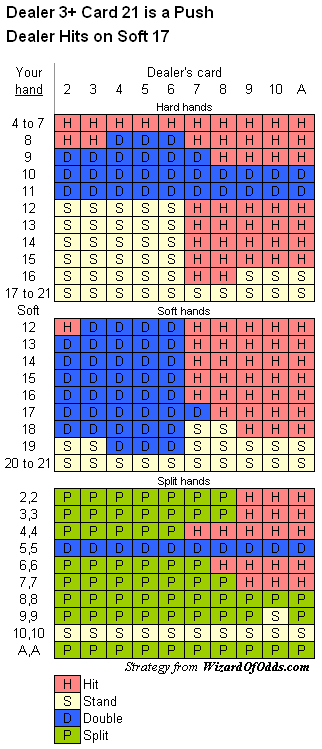Better Odds Blackjack Or Spanish 21

Spanish 21, a popular variant of blackjack, is played at casinos around the world.
While it’s new compared to the historic table game it’s based on, it has some intriguing rule changes that affect the house odds of the game.
The house edge for Spanish 21 is generally better than the house edge in blackjack. If you ignore the effect of those jackpot hands, which come up as rarely as you might expect, the house edge for Spanish 21 is about 0.4%. This assumes, of course, that you’re playing with perfect basic strategy. In Spanish 21, the player’s blackjack always beats the dealer’s blackjack. Anytime you draw a blackjack in the game, you’ll receive a 3:2 payout, regardless of the dealer’s hand. Late surrender is another key difference between Spanish 21 and other blackjack variants. Spanish 21 Odds and Probability & House Edge. Buying blackjack insurance in Spanish 21 should be avoided, as the lack of 10-cards reduces the chances of a dealer blackjack when showing an ace to just 25%. This gives the house an edge of 24.7% on insurance, which is sure to rank among the worst bets at any casino. Simpa Sibiu What Has Better Odds Spanish 21 Or Blackjack For the card counter, this is an easy walk in the park. Mobile Slots You may enjoy the best mobile slot games here at Ace Lucky Casino as we have a hand-picked selection of the very best mobile slots games for you to play and enjoy.
1 – What Are the Rules of Spanish 21?
Spanish 21 is still played on the same casino tables as the game it’s based on, but it uses a custom layout and a different ruleset.
The recreation is played with six or eight decks, which are drawn from a shoe. The dealer will receive a hole card in Spanish 21. A hole card is a card that’s dealt face down, meaning neither the dealer nor player can see the card’s value.
If a player gets a blackjack, consisting of one ace and one card with a value of 10, then they automatically win the game and receive a 3:2 payout, regardless of whether the dealer has blackjack.

Insurance and late surrenders are available in Spanish 21.
Even though there are four fewer 10-value cards in Spanish 21 than in blackjack, insurance is still paid out at 2:1. House edge on insurance in Spanish 21 is 24.7%, making the house edge one of the worst of casino wagers.
Late surrender is when the player surrenders after seeing the dealer’s hand but still has the chance to get half of their stake back after waiving the right to play on.
The dealer is able to peek under the hole card after his original two cards are dealt if the face-up card is an ace. If the dealer peeks and finds out that he has blackjack, all players automatically lose unless one of them has blackjack.
Anytime the player ends up with blackjack, they automatically win, regardless of whether or not the dealer has blackjack. Players will get paid out differently depending on how many cards they draw before hitting 21. A five-card 21 pays out 3:2, a six-card 21 pays out 2:1, and a 21 with seven or more cards pays out 3:1.
2 – How’s It Different From Blackjack?

Spanish 21 wasn’t introduced until 1995, so the blackjack variant has far less history than the game it’s based on. Blackjack’s predecessor is 21. A short story by Miguel de Cervantes indicates 21 has been played since the 17th century or earlier in Spain.
The history of blackjack began in Spain but spread to other European countries by the 18th century. In Britain, there’s evidence of the game dating back to the 1770s. After making its round through Europe, 21 finally came to America sometime in the 19th century. 21 was given its American name of blackjack by gold prospectors.
Prospectors called one of the minerals that indicated a gold or silver deposit “blackjack.” Top bonuses in casinos playing the game at the time were then named after the mineral. Eventually, the game itself was named blackjack.
A big rule change that gives a big boost to the player’s chances has to do with blackjacks. If you’ve ever been frustrated by the dealer drawing a blackjack on the same turn you do, then this rule will put your mind at ease.
In Spanish 21, the player’s blackjack always beats the dealer’s blackjack. Anytime you draw a blackjack in the game, you’ll receive a 3:2 payout, regardless of the dealer’s hand.
Late surrender is another key difference between Spanish 21 and other blackjack variants.
If the dealer doesn’t have a blackjack, you can surrender the game and get half your stake back. If you feel like the deck’s not in your favor, late surrender gives you a chance to minimize risk.
Doubling down also works differently in Spanish 21 than it does in blackjack. Blackjack only allows you to double down on the original two cards dealt, meaning you can only double your wager based on the first two cards you’re dealt.
Spanish 21 lets you double down on any cards you’re dealt in the game. Anytime you double down, you’ll receive another card. You can repeat this process twice, multiplying your bet by a maximum factor of eight, giving you the chance to receive a huge payout.
The lax double down rules of Spanish 21 work in conjunction with its laid-back late surrender rules. Even though doubling down increases the risk of your wager significantly, you can always late surrender and get half your stake back.
3 – Does Spanish 21 Have a House Edge?
The house edge for Spanish 21 will vary based on the dealer’s instructions for hitting or standing when their hand is a soft or hard 17.
Soft 17 is when the dealer’s hand has a sum of 17 and includes an ace.
For example, if the dealer’s hand had a six and an ace, it would be a soft 17. Soft 17 means the dealer could draw a 10 and the hand wouldn’t bust. The ace’s value would change to one and the dealer would have 18 in their hand.
Hard 17 is when the dealer’s hand doesn’t have an ace but has a value of 17.
For example, the dealer may have a six, another six, and a five. Hard 17 has the same rules at casinos but dealers may hit or stand on soft 17, depending on the casino’s rules.
The house edge will also change depending on whether or not you choose to double throughout the game.
With redoubling, the house edge will change to .42% for six decks and .45% for eight decks. The “Match the Dealer” side bet will have different house edges depending on how many decks are in play. The more decks that are in play, the lower the house edge will be for the side bet.
With two decks in play, the house edge is at 3.63% and suited matches have odds of 19:1. However, with eight decks in play, the house edge is at 2.99% and suited matches have odds of 12:1.
4 – What Side Bets Does Spanish 21 Offer?
A popular side bet on Spanish 21 is the super bonus. If a player has a 7-7-7 hand against a dealer seven, they’ll get the super bonus. The super bonus is $1000 on bets under $25 and $5000 on bets over $25. Splitting or doubling down will negate the super bonus.
All players at the table will receive a $50 envy bonus if another player at the table wins a super bonus. Another common side bet offered on this table game is Match the Dealer.
Better Odds Blackjack Or Spanish 21 Rules
If the rank of one or both of your original two cards matches the rank of the dealer’s face-up card, you can win this side bet. This is a pretty simple side bet to understand, but it can increase the fun of your hand and lets you try to predict which face-up card the dealer will give himself.
You can also make a second Match the Dealer side bet at some casinos. The second bet works the same as the first one, except you’re trying to match the dealer’s hole card this time.
5 – Where Can I Play Spanish 21?

Many casinos throughout the country offer this exciting blackjack variant. Rivers Casino Des Plaines, located in Des Plaines, IL, has Spanish 21 available to play in addition to other table games like baccarat, craps, and roulette.
The casino offers insurance at their Spanish 21 table letting players bet up to half the original bet on any hand. While you can double down on your hand at the casino, bonuses will not be paid out after you’ve doubled down on a hand.
Pair splitting is also available here. Players can split cards of equal value to create up to four hands. The casino also allows hitting and doubling of split hands.
Unlike doubled hands, bonuses can be paid on split hands, however, you will be ineligible for a super bonus after splitting your hand there.
Hawks Prairie Casino, located in Lacey, WA, also offers Spanish 21. House rules at this casino forbid the players from touching their cards at any time while playing and the casino also disallows side bets, so you won’t be able to make Match the Dealer bets there.
Better Odds Blackjack Or Spanish 21 Game
Conclusion
Better Odds Blackjack Or Spanish 21
Do you have any strategies for Spanish 21? Let us know in the comments section below.